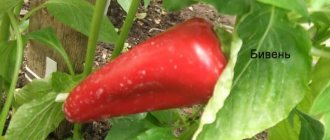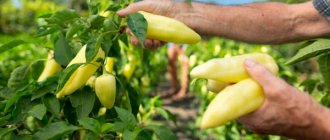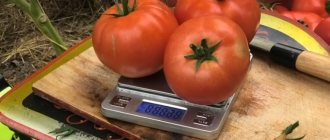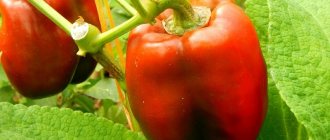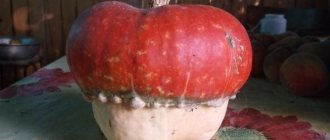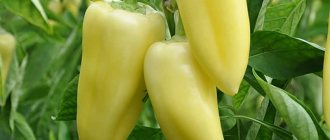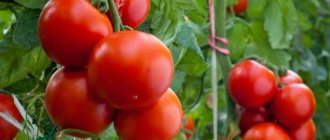We bring to your attention an article about a unique variety of pepper with large sweet fruits and the unusual name Big Mama.
This is one of the best varieties of recent years, belongs to the large “family” of big peppers, bred by the famous agro. The line of varieties includes Big Dad, Big Girl and Big Boy, all of which differ in the color of the fruit. Growing vegetables does not require any special skills. The plant is absolutely unpretentious; even a novice gardener can cope with agricultural technology.
What type of pepper is this?
The variety is new, developed quite recently, first registered in 2012 . The very word “Big” (large) already gives a certain characteristic to the variety. Big Mama fruits are bright orange in color and rich in beta-carotene, which determines the color of the vegetable.
Reference! Most people believe that orange peppers are the sweetest, although this is a misconception. However, orange color has a beneficial effect on a person’s psychological mood.
Characteristics and description of the variety
Big Mama is a variety with early fruit ripening . About 140 days pass from the appearance of the first shoots to full ripening. Designed for cultivation in open ground and in greenhouses. Has excellent taste.
Semi-spreading bushes with a height of 50 to 70 cm , in greenhouse conditions can reach 1 m. The leaves are medium-sized, smooth, dark green in color. The root system is powerful. The stems are strong, but during the fruiting period they require additional support in the form of a garter. The variety is resistant to many diseases of the nightshade family and is rarely attacked by pests.
Important! Outdoors, Big Mama is grown only in the southern regions of Russia.
Distinctive features
Big Mama peppers are grown using the traditional seedling method . Plants require additional feeding; regular watering with warm water and loosening the soil is important. It tolerates low temperatures well and is able to quickly recover from cold shock.
Fruit ripening lasts from August to September. In unfavorable weather conditions, peppers can ripen at home.
The photo shows the fruits of the Big Mama sweet pepper.
Fruit characteristics and yield
The fruits are large, cube-shaped . Average weight is about 120–150 g, maximum weight is 200 g. The surface of the skin is smooth, glossy, with slight ribbing on the sides. The pulp is fleshy and juicy, ranging from 6 to 12 mm thick.
The color of ripe peppers is bright orange, and during the period of technical maturity it is green. The fruits are suitable for both fresh storage and freezing. Universal use: fresh consumption, preservation, cooking.
Seed germination rate is about 80% . Productivity is high: about 7 kg of fruits per 1 sq. m. Big Mama is not inferior in yield to the famous variety Californian Miracle and is far superior to another popular variety Belozerka.
Attention! Orange peppers are not the sweetest. They are inferior in sweetness to red peppers. But fruits of orange and yellow colors are especially rich, compared to peppers of other colors, in vitamin P, potassium, phosphorus, iron and rutin - a substance that strengthens the walls of blood vessels.
Description and characteristics of the variety. Sweet large-fruited pepper - fat man: "Big Mama"
Fruit characteristics
It is difficult to dispute the attractiveness of the Big Mama pepper fruits; they captivate at first sight. But what other characteristics are characteristic of these peppers?
- The shape of the peppers can be called cuboid, although since they are slightly elongated in length, they more likely resemble a cylinder, slightly flattened on the sides. Some gardeners call these barrel peppers. Their growth form is drooping.
- The surface of the skin is smooth, attractive with a strong gloss. There is slight ribbing on the sides.
- The color of the fruit is attractive with a juicy orange color; in a state of technical maturity it is dark green. But compared to many mid-season varieties, peppercorns color quite quickly.
- The fruits grow large; it is not uncommon for the weight of one fruit to be 200 grams. On average, their weight is 120-150 grams.
- The walls are thick and dense, their thickness reaches 10-12 mm, on average 7-8 mm. The pulp is fleshy and juicy.
- In terms of taste characteristics, the fruits of this variety deserve an exceptionally excellent rating. It is best to eat them fresh, straight from the bush. But peppercorns are universal in purpose. They make excellent salads and stuffed dishes, and you can also use them to prepare many delicious and very beautiful-looking preparations.
- The fruits keep well fresh and are suitable for freezing for the winter.
Preparation for cultivation
Varietal pepper Big Mama requires preliminary preparation for cultivation :
- First, the seeds are soaked for several hours in plain water. It is best to use melt water (melted snow).
- Then they are placed in a growth stimulator. Suitable solutions include aloe juice, infusion of onion peels and ash, and honey water. You can also use store-bought products: “Novopin”, “Zircon”, “Epin”, “Immunocytophyte” and others.
- A few hours after soaking, the seeds are removed from the solution and dried before planting.
Sowing is done in February (if planting is planned in a greenhouse) and in early March (when planting in open ground). Seedlings require special soil designed for planting tomatoes and peppers. Vermicompost, coconut extract and fertilizer (for example, Shungi Terra) are added to the soil. After seed germination, after 8–10 days, the shoots are placed in special containers for further growth.
Reference! Soaking seeds increases the percentage of germination and ensures uniform germination.
Features of agricultural technology
To obtain strong and healthy seedlings, their age should be approximately 65-70 days. Therefore, depending on the area of residence, summer residents themselves navigate the timing of the start of sowing work.
Growing seedlings
Before sowing peppers, prepare the soil for seedlings. To do this, you can use various types of soils that are offered by trade, or prepare the soil mixture yourself.
To do this, garden or garden soil is mixed with compost and ash. If the mixture is not loose and light enough, add peat or coconut substrate. To destroy pathogenic bacteria, the soil is disinfected with a weak solution of potassium permanganate.
May be interesting Methods of growing and care required for the cucumber variety “Ira f1” “Pink Flamingo” - the most delicious of tomatoes Irbitsky potato variety: description and characteristics, reviews
Boxes for seedlings should have drainage holes in the bottom to avoid stagnation of water when watering.
Before sowing, the seeds are treated:
- For disinfection - in a solution of phytosporin or potassium permanganate (15-20 minutes), then washed.
- In a solution of growth stimulants or microelements (5-6 hours).
- The treated seeds are wrapped in a damp cloth, placed in a bag or jar, which is placed in a room with a temperature of 24-25 degrees.
- Keep moist, adding a little water if necessary to avoid drying out.
To improve germination, you can use seed treatment using bubbling - for which, before soaking, the seeds are placed in a jar of water and a compressor (can be an aquarium compressor) creates a flow of air bubbles.
The seeds hatch after 4-5 days, after which they are sown in prepared, moist soil. When planting in boxes, the distance between seeds is 3-4 cm, and 7-8 mm of soil is poured on top.
To speed up the germination of peppers, the boxes are covered with film or paper to create a greenhouse effect, and placed at a temperature of 24-25 degrees. until the seedlings appear.
Growing seedlings
To ensure that the seedlings are suitable for further planting, follow a few simple rules :
- Seedlings are prepared approximately 3 months before the expected date of planting in the garden.
- Containers with seedlings are covered with plastic film in order to maintain a certain microclimate and maintain moisture levels.
- Water regularly: 2-3 times a week.
- Young shoots will need 12 hours of light - use additional light sources.
- Regardless of the further method of cultivation (in a greenhouse or in open ground), the seedlings must be planted in soil heated to at least +15 °C.
- Before planting in the ground, hardening is necessary. Over 1-2 weeks, the air temperature is reduced at night to +12–14 °C. 3-5 days before planting, the temperature should be consistent with outdoor conditions. To do this, the seedlings are taken out onto a glassed-in balcony and left there for the remaining time.
Attention! The amount of moisture required depends on the temperature. The warmer the room where the seedlings are grown, the more water they need.
Seedlings can be grown in two ways:
- With picking: the seeds are sown in a common box, then the sprouts are transplanted into separate cups.
- Without picking - directly into separate containers with a volume of 300 to 350 ml.
It is better to cultivate peppers without picking , since after planting the seedlings noticeably slow down their growth, sometimes stopping for 1-2 weeks. This is due to the increased sensitivity of the fragile roots of the vegetable to any, even the most insignificant, mechanical impact.
If you choose the picking method, keep in mind : the older the plant, the easier it is to replant it without damaging the root system. Before removing the sprout from the ground, water it well - this will make it easier to get the seedlings. Make small holes in the cups at the bottom and sides of the bottom. Replant the plant carefully, without bending the root. It must be planted at the same depth at which the seedling grew.
Planting pepper
Seedlings are planted in the garden from the moment the first flowers appear . If the temperature does not yet meet optimal levels (below 15 ° C), a temporary shelter is built. Peppers are planted according to a 35x50 cm pattern or a little looser. Burying seedlings is excluded. It is recommended to mulch the soil using a thin layer of humus or peat chips.
Reference! Mulching the soil will help combat possible drying out of the soil and weeds.
Further care
Big Mama pepper is especially moisture-loving . The soil should be moderately moist at all times.
Feeding the plant is mandatory : the first time 10–12 days after planting the seedlings, the second time immediately after mass flowering. The peppers are fertilized a third time after the appearance of the first fruit, which acquires an orange color. Use mineral or organic fertilizers, but do not overdo it with nitrogen.
The bushes do not require special shaping . You just need to remove those branches that have grown below the first fork.
Timely weeding helps accelerate the development of the plant. This is also good prevention against pests.
Fruits can be harvested at a state of technical maturity. They, just like orange peppers, are tasty and healthy. This makes it easier for the next peppers to grow.
Reference! An excess of nitrogen can provoke active growth of the plant, prompting it to produce new shoots, but there will not be a high yield.
Pepper care
The pattern for planting peppers is 50x35 cm, the holes are prepared in advance. The soil should be fertilized in the fall (organic matter - up to 5-6 kg, ash and superphosphate - 50 grams each). The standards are given per square meter.
The holes are spilled with water, and the seedlings are carefully planted with a clod of earth, immersing the cotyledon leaves into the soil.
Further care is:
- watering;
- loosening;
- fertilization;
- prevention from diseases and pests.
Watering
Sweet peppers love moisture, but cannot tolerate waterlogged soil. You need to especially carefully control watering in the greenhouse, since there, in a closed space, it is more difficult to maintain optimal humidity levels.
Peppers are watered more abundantly at the beginning of flowering, as well as at the moment the fruit begins to set. They also take into account the weather, watering the plants more often on hot days.
Loosening
Loosening is carried out after watering, preventing the appearance of an earthen crust
The roots of peppers are shallow, so it is important not to damage them when loosening. All weeds must also be removed
Fertilizer application
When gardeners complain about low yields of sweet peppers, they need to figure out whether all the requirements for the crop’s agricultural technology have been met correctly and in full. You won’t get tasty and juicy fruits if you don’t take care of high-quality plant nutrition.
To get a good harvest, you need to use high-quality seeds. The most productive varieties are possible. Large selection of varieties for every taste.
The first time sweet peppers need to be fed is approximately 21-15 days after planting the seedlings. Slurry that is diluted in water (1:10) is suitable.
The second feeding is carried out during the flowering period, the third - when fruit formation begins. For these fertilizers, compositions with a predominance of potassium and phosphorus are selected. Apply foliar feeding (about once a month), spraying the plants on the leaves.
Formation of sweet pepper bushes
Despite the fact that the Big Mama variety grows no more than 60-70 cm in open ground, its bushes need to be shaped. This will increase the yield of pepper and get full-fledged large fruits.
- The bud that forms first needs to be removed.
- Remove all flowers and ovaries at the fork of the pepper stem.
- Only two strong and powerful stems are left, the rest are removed.
- Remove all side shoots and shoots in the leaf axils.
- In August, it is recommended to pinch the growing points of the main fruit-bearing shoots on the bush.
In a greenhouse, where peppers grow taller, formation is mandatory.
IMPORTANT! The formation of sweet peppers not only increases the number of fruits, but also improves the growing conditions of plants. Removing excess shoots promotes good air ventilation in the greenhouse, minimizing the risk of various infections.
Features of growing the variety and possible difficulties
peppers are suitable for growing in any climatic conditions . The period for planting seedlings largely depends on the region where the planting takes place.
Attention! You cannot plant peppers in an area where nightshades previously grew, as they deplete the soil, taking away almost all the microelements necessary for pepper growth.
During the entire growing season, the bushes must be tied up . Removing the first stepsons and buds will increase the yield.
Despite the fact that growing Big Mama is no more difficult than any other variety of pepper, if not properly cared for, you can encounter certain difficulties (see table below).
| Problem | Possible reason | Solution |
| Pepper does not produce buds for a long time | The nitrogen content in the fertilizer is exceeded. Use of manure. | Use a fertilizer with low nitrogen content. Do not use manure fertilizer. |
| The pepper is blooming, but there are no ovaries | High humidity in the greenhouse. The air temperature is too high. Severe and sharp cold snap (below +12 °C). | Spray the bushes with a special solution in the daytime (Bud or Ovary preparations are suitable). Ventilate greenhouses in hot weather. Heat greenhouses during prolonged and severe cold spells. Reduce watering. |
| Flowers or ovaries fall off | The plant suffered a frost. Excess nitrogen in the soil. Soil drying out. A sharp difference in night and day temperatures (more than 15 ° C). Prolonged cold snap. Watering with cold water. The plant was exposed to a disease: fruit rot. | Spray the pepper leaves in the evening with Uniflor Bud fertilizer. |
| The stem is rotting | Stem rot caused by poor ventilation (if peppers grow in a greenhouse) and high air humidity. | Stop watering when the first signs of disease (white plaque) are detected. Ventilate the greenhouse regularly. Remove all leaves and stem shoots up to the fork. Thin out the stems of each bush. Remove plaque by treating the affected area with a strong solution of potassium permanganate. |
| A light spot has formed on the top or side of the fruit | Top rot caused by a lack of potassium, calcium, and water. | Water. Feed with potassium and calcium. |
| The leaves curl or rise up and have a brown edge. | Lack of potassium and phosphorus. | Use Uniflor Bud fertilizer. Feed with superphosphate. |
| The leaves have brightened | Lack of nitrogen. | Feed the plant with weed infusion, diluting it with water in a ratio of 1:5. |
General description of the variety
The Big Mama pepper variety was included in the State Register of the Russian Federation in 2011, and the originator is Agro.
The average height of a semi-spreading plant is 1.5 m. In open beds without the formation of a stem, pepper does not grow more than a meter. If the bush is grown in closed structures and is formed into several stems, the plant can reach limits of 1.6-1.7 m.
The cultivar, adapted to unfavorable factors, tolerates sharp changes in day and night temperatures in spring. Even under unregulated growing conditions, Big Mama shows good fruit set and long fruiting.
Fruit characteristics
The fruits of the variety are large, cube-shaped, weighing up to 200 grams. The skin of the pepper is smooth and glossy, green in color at the stage of milky ripeness. When fully ripe, the color changes to bright orange (see photo).
The flesh of Big Mama is very juicy, fleshy, with a pronounced peppery aroma. The length of one vegetable reaches 12-13 cm with a diameter of 11 cm. The pericarp wall has a thickness of approximately 8-8.5 mm.
Peppers are intended for universal use: they can be frozen, stuffed, or added to first and second courses. The variety is not suitable for whole-fruit canning due to its impressive size.
The nutritional value of Big Mom is its high content of carotene and vitamin C.
Productivity
On one bush, without shaping, from 4 to 7 large fruits set and grow. When forming a crop with 2 or 3 stems, the number increases approximately 2 times: this agrotechnical approach allows you to get up to 12 vegetables from a bush.
When grown in a greenhouse and following all recommendations for caring for 1 sq. m. up to 10 kg of vegetables are collected. In unprotected soil the figures are more modest - 4 kg from the same area.
Typical diseases and pests
The table shows the most common diseases and pests of peppers , as well as ways to combat them.
| Diseases and pests | Signs | Ways to fight |
| Fruit rot at the point of attachment of the fruit. | The ovaries fall off. | Spray the pepper leaves with Uniflor Bud in the evening. |
| Stem rot caused by poor ventilation | White coating on stems and leaves. | Stop watering temporarily. Ventilate the greenhouse regularly. Remove all leaves and stem shoots up to the fork. Thin out the stems of each bush. Remove plaque by treating the affected area with a strong solution of potassium permanganate. |
| Spider mite | Bronze or white color on leaves. | Spray the damaged areas of the plant with Malathion. Water with dandelion infusion. |
| Aphid | Pests are visible to the naked eye on the underside of leaves. | Water with tobacco solution in the morning. Water with dandelion infusion. |
| Slugs | Large holes on the leaves. | Place grains of “Groza” or “Meta” preparations near the stems and tie the lower stems with nettles. Pour the peppers with a 9% vinegar solution diluted in water (0.5 tbsp vinegar per 5 liters of water). Be sure to sprinkle the soil with ash to prevent acidification. Remove slugs mechanically (collect by hand). |
Advantages and disadvantages of the variety
The variety has no significant disadvantages .
In rare cases, the plant does not take root or does not bear fruit. Most often, such problems are caused by errors in care or other reasons listed in the table above. The Big Mama variety has plenty of positive qualities :
- excellent taste;
- beautiful appearance of the fruit;
- high seed germination;
- high productivity;
- good survival rate of young plants;
- relative ease of cultivation;
- unpretentiousness;
- cold resistance;
- immunity to disease;
- high content of vitamins and minerals (vitamin C, P, carotene, phosphorus, potassium, calcium, iron, etc.).
Soil and seed preparation
You should first prepare the seeds for planting. First, it is necessary to disinfect them. It is enough to hold the seeds for 10-15 minutes in a weak solution of manganese water. Secondly, you can soak them in aloe juice, which will increase the vitality of the seedlings. Since this variety does not have 100% germination, gardeners do not recommend neglecting processing. It will increase the number of seedlings and, accordingly, get a rich harvest.
Reviews
Most reviews about the Big Mama variety are positive . People note its good yield, unpretentiousness, early ripening, excellent taste and attractive bright orange color.
Olga, Kaluga : “I really liked the variety, I’ve been growing it for two years now. I planted it in a garden bed, not in a greenhouse, and at the end of July the first orange fruits appeared. All other peppers ripened a little later, around mid-August. Advantages: unpretentious, does not require special care. It grew in rather poor soil, but the harvest was good.”
Evgenia, Saransk : “I immediately liked this variety of pepper for its appearance on the bags. The seeds were very inexpensive. Shoots appeared quickly. Of the three varieties planted at the same time, Big Mama sprouted the earliest - on the eighth day. It also developed quite quickly. After three months, beautiful little peppers formed. Already in August they all ripened and became a rich orange color.”
Oleg, Krasnoyarsk : “Orange peppers were grown for the first time, previously only red ones. We bought Big Mom seeds because we liked the description on the package. The reviews are also good. They planted it in a greenhouse. There were a lot of fruits, large, cube-shaped. Very sweet and juicy. I'm pleased with the variety. I paid a little more attention to it because it is new to me. The fruits are great for stuffing.”
Characteristics of the Big Mama pepper
As is customary for gardeners, they begin to plant seedlings several months before the summer season. The time for planting each type is individual, for example, cabbage is planted in mid-February, and chrysanthemums are usually not earlier than April.
Similarly, like cabbage, “Big Mama” peppers are planted in mid-to-late February, however, the pepper needs to create the most favorable conditions for subsequent good fruiting. First of all, it is important to provide the pepper with as much light as possible, this will help speed up the appearance of the first shoots. For this reason, many gardeners believe that it is best to plant peppers in March, when there will be enough sunlight for favorable pepper growth, and there will be no need to create artificial lighting.
However, this species belongs to those varieties that ripen and grow early. Therefore, experienced gardeners say that February is not the best time to plant Big Mama peppers. It is necessary to plant this species, preferably at the end of January, since the harvest will then appear much faster. And this aspect is decisive for many gardeners.
Gardeners claim that by allowing Big Mama peppers to grow on their plots, they end up with fairly large, bright orange, rectangular fruits. They are smooth to the touch and have no prominent ribs. Their weight is up to 200 g. The ripening period of “Big Mama” is two to three months, so after planting very soon you will be able to serve delicious peppers on your table as a component for a salad or a whole fruit stuffed with various fillings.
Fact. If you grow Big Mama peppers in greenhouses, the bushes on which the fruits appear can reach a height of a meter.
Gardeners quite often praise not only the size of the Big Mama pepper, but also its taste. This variety tastes very sweet and quite juicy. Gardeners often use this species for various purposes. They claim that it is universal and can be suitable not only as a culinary ingredient, but also for subsequent preservation.
Thus, the main advantages of Big Mama pepper include the following:
- excellent taste and tender pulp;
- high ripening speed;
- high productivity;
- large fruits;
- The plant is unpretentious to the conditions of maintenance and care.

